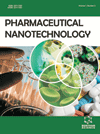- Home
- A-Z Publications
- Pharmaceutical Nanotechnology
- Issue Home
Pharmaceutical Nanotechnology - Current Issue
Volume 13, Issue 2, 2025
-
-
Recent Advancements in Nanopharmaceuticals for Novel Drug Delivery Systems
More LessNanoparticles have found applications across diverse sectors, including agriculture, food, cosmetics, chemicals, mechanical engineering, automotive, and oil and gas industries. In the medical field, nanoparticles have garnered considerable attention due to their great surface area, high solubility, rapid dissolution, and enhanced bioavailability. Nanopharmaceuticals are specifically designed to precisely deliver drug su Read More
-
-
-
Optimizing Intranasal Amisulpride Loaded Nanostructured Lipid Carriers: Formulation, Development, and Characterization Parameters
More LessAuthors: Manar Adnan Tamer and Hanan Jalal KassabBackgroundNanostructured lipid carriers (NLCs) are lipid-based nanoparticles composed of a mixture of solid and liquid lipids, which are stabilized by the outer surface of a surfactant.ObjectivesThis research aimed to prepare intranasal nanostructured lipid carriers loaded with amisulpride to enhance its dissolution and bioavailability using different formulation compositions.MethodsAmisulpride nanostructured lipid carriers wer Read More
-
-
-
Comparative Study of Liposomal and Ethosomal Formulations of Curcuma heyneana Rhizome Extract in a Transdermal Delivery System
More LessAimsThis study aimed to develop an anti-aging nanoformulation with Curcuma heyneana extract as bioactive substance.BackgroundCurcuma heyneana Valeton & Zipj extract has been proven in previous research to have antioxidant, anti-ageing, anti-inflammatory, and wound healing properties, which makes it a potential bioactive material for anti-ageing and sunscreen cosmetic products. Phytoantioxidants need to pe Read More
-
-
-
Crocin-loaded Niosomal Nanoparticles Reversing Cytotoxicity and Oxidative Stress in HEK293 Cell Line Exposed to Paraquat: An In vitro Study
More LessBackgroundParaquat (PQ) is an effective herbicide which is widely used around the world to remove weeds in agriculture. As a water-soluble carotenoid, crocin is a pharmacologically active constituent of C. sativus L. (saffron).ObjectivesIn the present study, we investigated the effects of crocin-loaded niosomes (Cro-NIO) compared to free crocin on PQ-induced toxicity in the eukaryotic human embryonic kidney (HEK293) Read More
-
-
-
Development and Characterization of Sulfasalazine Cubosomes for Potential Transdermal Drug Delivery
More LessAuthors: Mekha Mathew, Anasuya Patil and Hemanth GBackgroundRheumatoid arthritis is indeed a constant, progressive autoimmune disease that acts on the synovial membrane, distinguished by joint pain, swelling, and tenderness. Sulfasalazine belongs to BCS Class IV having low solubility and low permeability. To overcome the issue and provide a localized effect Cubosomes were chosen for the transdermal drug delivery system.ObjectivesThe primary objective of this investigatio Read More
-
-
-
Formulation Optimization and Characterization of Tizanidine Hydrochloride-loaded Gold Nanoparticles Using Quality by Design Approach
More LessBackgroundGold nanoparticles (GNP) have been used extensively in cancer biologics and as drug carrier systems for improved pharmacokinetics and effective therapeutic action. GNPs also ensure reliable diagnosis with sensitive imaging.ObjectivesThis study aimed to synthesize tizanidine hydrochloride (TZN)-biodegradable gold (Au) nanoparticles by the reduction of chloroauric acid (HAuCl4) with trisodium citrate using a Read More
-
-
-
Characterizing Nanoparticle Isolated by Yam Bean (Pachyrhizus erosus) as a Potential Agent for Nanocosmetics: An in vitro and in vivo Approaches
More LessAuthors: Maesa Ranggawati Kusnandar, Indra Wibowo and Anggraini BarlianBackgroundThis study investigated the potential of Plant-Derived Exosome-Like Nanoparticles (PDENs) as cosmeceutical nanocarriers for treating skin problems, such as scar removal, face rejuvenation, anti-aging, and anti-pigmentation.ObjectivesResearchers isolated PDENs from Yam Bean (Pachyrhizus erosus) using PEG-based precipitation, gradual filtration, and various centrifugations at low temperatures. Followed by in vit Read More
-
-
-
Potential of Plant-derived Exosome-like Nanoparticles from Physalis peruviana Fruit for Human Dermal Fibroblast Regeneration and Remodeling
More LessAuthors: Filia Natania, Iriawati Iriawati, Fitria Dwi Ayuningtyas and Anggraini BarlianAimsThis research aimed to study the potential of PDEN from P. peruviana fruits (PENC) for regenerating and remodeling HDF.BackgroundLarge wounds are dangerous and require prompt and effective healing. Various efforts have been undertaken, but have been somewhat ineffective. Plant-derived exosome-like nanoparticles (PDEN) are easily sampled, relatively cost-effective, exhibit high yields, and are non-immunoge Read More
-
-
-
The Incorporation of Clove Essential Oil into Nanostructured Lipid Carrier for Improvement of the Delivery and Antioxidant Effects on the Fibroblast Cells
More LessAuthors: Satrialdi, Nada Nurul Husna, Risya Qonitah Rihad and Ratna Annisa UtamiBackgroundClove (Syzygium aromaticum) essential oil (CO) has been studied extensively for its antioxidant properties but faces several limitations, including high volatility, low aqueous solubility, and irritation.ObjectiveWe aimed to develop a Nanostructured Lipid Carrier (NLC) to enhance the benefits of CO.MethodsUsing the emulsification sonication method, a liquid lipid component, surfactant concentration, and a co-surfacta Read More
-
Most Read This Month Most Read RSS feed
Article
content/journals/pnt
Journal
10
5
false
en


